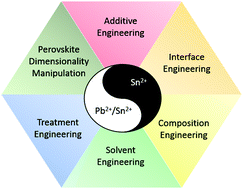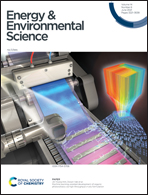Toward highly efficient and stable Sn2+ and mixed Pb2+/Sn2+ based halide perovskite solar cells through device engineering
Abstract
Lead halide perovskite (LHP) has gained tremendous attention from both academia and industry due to its excellent optical and electrical properties. To date, the power conversion efficiency (PCE) of a small area LHP solar cell has reached 25.5%. However, lead (Pb2+) element in perovskite compounds is toxic and harmful to the environment and human health. Additionally, LHP exhibits a larger energy bandgap (Eg) that is not within the optimal range in the Shockley–Queisser (S–Q) maximum efficiency limit, which has further limited the maximum attainability of the device performance. In order to reduce Pb2+ concentration in perovskite compounds and alter Eg close to the optimal range S–Q efficiency limit, tin (Sn2+) has been proposed to fully or partially substitute Pb2+ due to their similar ionic radii and outer electronic configurations. Even though the power conversion efficiencies (PCEs) of Sn2+ and mixed Pb2+/Sn2+ perovskite solar cells (PSCs) have seen rapid improvement in recent years, they are still far behind that of Pb2+ PSCs because the high number of defects in Sn2+ based halide perovskites induces poor morphology and poor optoelectronic properties in the perovskite films. Therefore, in this review, we will provide the challenging issues of Sn2+ halide perovskites and methodologies (i.e. device engineering) to boost the efficiency and stability of Sn2+ and mixed Pb2+/Sn2+ based single-junction PSCs. At the same time, we also show future perspectives and remaining challenges in this field, with an aim to help further progression of efficient and stable Sn2+ and mixed Pb2+/Sn2+ PSCs.



 Please wait while we load your content...
Please wait while we load your content...